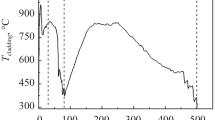Abstract
The reasons for unsealing of VVER and RBMK fuel elements are discussed on the basis of the results of post-reactor investigations. The fuel elements in both types of reactors become unsealed because of their interaction with foreign objects present in the coolant flow. The mechanisms of the degradation of some properties of the unsealed fuel elements during further operation are determined.
Similar content being viewed by others
REFERENCES
A. Kirushkin, V. Tchirkov, E. Sidorova, and V. Novikov, “Evaluation of the operation performance of VVER fuel manufactured by JSC MSZ, Russian Federation,” in: Proceedings of the 4th International Conference on “WWER Fuel. Performance, Modeling, and Experimental Support,” Varna, Bulgaria, October 1–5, 2001, 2002, pp. 27–32.
A. Strasser and D. Sunderland, “A review of recent LWR fuel failures,” in: Proceedings of IAEA TCM “Fuel Failure in Normal Operation of Water Reactors: Experience, Mechanisms, and Management,” Dimitrovgrad (1992), IAEA-TECDOC-709, IAEA, Vienna (1993), pp. 17–25.
A. Strasser and J. Gingold, “An evaluation of debris fretting failures and preventive methods,” ibid., pp. 138–143.
R. Yang, “Meeting the challenge of managing nuclear fuel in a competitive environment,” in: Proceedings of International Topical Meeting on Light Water Reactor Fuel Performance, ANS, Portland, Oregon, March 2–6, 1997, pp. 3–10.
D. Locke, “The behavior of defective reactor fuel,” Nucl. Eng. Design, No. 2, 318–330 (1972).
D. Locke, “Mechanism of deterioration of defected LWR fuel,” in: The Behavior of Zirconium Alloy Clad Ceramic Fuel in Water Cooled Reactors IWGFPT-6, IAEA, Vienna (1980), pp. 101–112.
J. Davies, “Secondary damage in LWR fuel following PCI defection-characteristics and mechanisms,” ibid., pp. 135–147.
B. Lewis, K. Macdonald, and N. Ivanoff, “A review of fuel performance and fission product release studies for defected fuel elements,” in: Proceedings of AEA TCM “Fuel Failure in Normal Operation of Water Reactors: Experience, Mechanisms, and Management,” Dimitrovgrad (1992), IAEA-TECDOC-709, IAEA, Vienna (1993), pp. 79–99.
H. Mogard, M. Grounes, H. Tomani, and G. Lysell, “Studies in R2 test reactors of secondary damage formation in LWR fuel rods with simulated defects,” ibid., pp. 184–192.
L. Lundholm, B. Grapengiesser, D. Schrire, and L. Hailstadius, “ABB atom fuel failure — an overview, S-721 63 Vasteras, Sweden,” ibid., pp. 57–63.
Author information
Authors and Affiliations
Additional information
__________
Translated from Atomnaya Energiya, Vol. 99, No. 5, pp. 376–380, November, 2005.
Rights and permissions
About this article
Cite this article
Markov, D.V., Perepelkin, S.O., Polenok, V.S. et al. Reasons for Unsealing and Post-Reactor State of Unsealed VVER and RBMK Fuel Elements. At Energy 99, 810–814 (2005). https://doi.org/10.1007/s10512-006-0021-8
Received:
Issue Date:
DOI: https://doi.org/10.1007/s10512-006-0021-8



